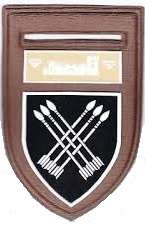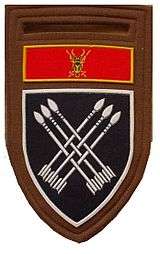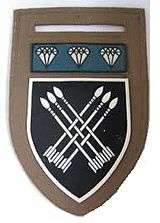32 Battalion (South Africa)
| 32 Battalion | |
|---|---|
|
Unit insignia | |
| Active | 1975–1993 |
| Country |
|
| Branch |
|
| Type | Light Infantry |
| Part of | South African Defence Force |
| Nickname(s) | Os Terríveis (The Terrible Ones) |
| Motto(s) | Proelio Procusi (The Forged in Battle) |
| Engagements | South African Border War |
| Disbanded | 26 March 1993 |
| Commanders | |
| Founder | Colonel Jan Breytenbach |
| Subsequent commanders |
|
| Insignia | |
| Battalion Flag |
 |
32 Battalion (sometimes nicknamed Buffalo Battalion or Portuguese: Os Terríveis for The Terrible Ones) was a light infantry battalion of the South African Army founded in 1975, composed of black and white commissioned and enlisted personnel. It was disbanded on 26 March 1993.[1]:280
History
Military refugees
After the victory of the Movimento Popular de Libertação de Angola (MPLA) in the Angolan War of Independence in 1975, many troops of its main rival, the Frente Nacional de Libertação de Angola (National Liberation Front of Angola, FNLA), found refuge in the then South African-controlled South West Africa.[2]
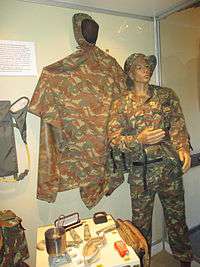
Formation of Bravo Group
From these troops, Colonel Jan Breytenbach together with Commandant Sybie van der Spuy formed a unit that was initially known as Bravo Group but later renamed 32 Battalion. Initially, Bravo Group consisted of two infantry companies, a mortar platoon, an anti-tank section and a machine gun platoon, but 32 Battalion was finally expanded to seven infantry companies, a recce wing, and a support company consisting of 81 mm mortar, anti-tank and machine gun sections.

Redeployed as the SADF
Unlike other South African Defence Forces (SADF) units, 32 Battalion was mainly deployed in southern Angola, acting as a buffer between the SADF's regular forces and its socialist enemies. The unit was also used to assist the anti-communist movement of the National Union for the Total Independence of Angola (UNITA). Although it was mainly used as a counter-insurgency force it was eventually also used as a semi-conventional force, especially during the later phases of the war – particularly at the Battle of Cuito Cuanavale.
The battalion consisted of around 600 riflemen and NCOs (non-commissioned officers) (mostly Angolan nationals associated with the former FNLA) and mainly South African officers, although commissioned military personnel from countries such as Australia, Rhodesia, Portugal and the United States were active with the battalion, especially in its early stages. As time progressed a number of SNCOs (senior non-commissioned officers – sergeants and above), distinguished themselves and were commissioned.[3]
Namibian Independence
After Namibian independence in 1989, the unit was withdrawn to South Africa where it was used in a counter-insurgency role and later also in the South African townships. At the end of its era in Namibia, the unit had developed into a conventional battle group. Apart from the infantry companies and the recce company, the battalion was strengthened by a battery of 120 mm mortars, a squadron of Ratel ZT-3 and 90 mm tank destroyers and a troop of 20 mm anti-aircraft guns mounted on Buffel infantry vehicles. Although the main bulk of the battalion was based at Buffalo on the banks of the Okavango River, the HQ was in Rundu, 200 km to the east.
The Phola Park Incident
On 8 April 1992 members of 32 Battalion were involved in an incident in Phola Park, Gauteng where members of the public were shot and killed.[4] The incident drew widespread criticism, specifically from the African National Congress (ANC)[5] and prompted the Minister of Defence to request an investigation by the Goldstone Commission.
Disbandment
As one of the results of the negotiations between the National Party and the ANC, the unit was disbanded in March 1993 and its members were retired to the town of Pomfret, South Africa.[6]
The guys who did so much dying and fighting for this country were just sort of disbanded on the spur of the moment. It just isn't right. I think it is terrible. I think they were betrayed, quite honestly.[7]— Colonel Jan Breytenbach
Many members of the unit later helped to found or joined private military companies such as Executive Outcomes and Sandline International, which ironically fought on the side of the Angolan government against UNITA.
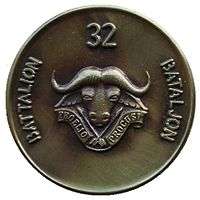
Equatorial Guinea coup
Some of the participants in the alleged 2004 Equatorial Guinea coup d'état attempt were former members of 32 Battalion.[8][9] Because they were arrested in Zimbabwe, it is not clear whether any of those arrested had full knowledge of their final destination or the alleged coup d'état.[10]
Decorations
The battalion was one of the most decorated units during the South African Border War, with a total of 13 Honoris Crux medals for bravery awarded to its members, second only to the South African Special Forces Brigade, whose members were awarded 46 Honoris Crux medals during the same period.
- Lieutenant Connie van Wyk
- Sergeant Danny Roxo
- Warrant Officer 2 Willy Ward
- Major Eddie Viljoen
- Lance Corporal Feliciano Costa
- Corporal Eduardo João
- Second Lieutenant Petrus Nel
- Corporal Victor Dracula
- Rifleman Bernardo Domingos
- Major Hannes Nortmann
- Sergeant Rihan Rupping
- Captain Petrus van Zyl – Operation Modular
- Lieutenant Tobias de Vos – Operation Modular
In fiction
In the film Blood Diamond, Leonardo DiCaprio's Rhodesian character "Danny Archer" was a former member of 32 Battalion.
Roll of Honour
- 1980: Alberto,R., Rfn[11]:1763[lower-alpha 1]
- 1980: Albino,B., Rfn [11]:1767[lower-alpha 1]
- 1980: Almeido,P., Rfn [11]:1764
- 1987: Alves,J.R., 2Lt [11]:10[lower-alpha 1]
- 1980: Angelo,S., Rfn [11]:1765[lower-alpha 1]
- 1984: Antonio,D., Rfn [11]:15
- 1987: Antonio,G., Rfn [11]:16[lower-alpha 1]
- 1985: Antonio,P., Rfn [11]:18[lower-alpha 1]
- 1984: Antonio,D., Rfn [11]:36058
- 1983: Augusto,J., Rfn [11]:30
- 1980: Augusto,M., Rfn [11]:1766[lower-alpha 1]
- 1984: Aurelio,A., Cpl [11]:31[lower-alpha 1]
- 1982: Bambi,M., Rfn [11]:41[lower-alpha 1]
- 1982: Baptist,J., Rfn [11]:32
- 1987: Batisda,A.N.D., Cpl [11]:56[lower-alpha 1]
- 1980: Braz,S.D., Sgt [11]:1713[lower-alpha 1]
- 1978: Britz,R.N., 2Lt [11]:162
- 1987: Cassela,D., Rfn [11]:200[lower-alpha 1]
- 1985: Chihamba,J.C., Rfn [11]:206[lower-alpha 1]
- 1980: Chipa ,A.F., Rfn [11]:36617
- 1985: Chipoya,Z., Rfn [11]:208[lower-alpha 1]
- 1980: Coetzee,M.C., Cpl [11]:1722[lower-alpha 1]
- 1979: Coetzee,S.W., 2Lt [11]:237[lower-alpha 1]
- 1982: Conroy,J., Sgt [11]:248
- 1983: Da Silva,G.P., Rfn [11]:274[lower-alpha 1]
- 1984: Da Silva,L.A., Rfn [11]:275
- 1982: Dala,F., Rfn [11]:276
- 1987: Dala,G., Rfn [11]:277[lower-alpha 1]
- 1984: Dala,J., Rfn [11]:278[lower-alpha 1]
- 1985: De Almeida,A., Rfn [11]:289[lower-alpha 1]
- 1987: De Klerk,M.M., L-Cpl [11]:310[lower-alpha 1]
- 1979: De Vos,W.A., 2Lt [11]:332[lower-alpha 1]
- 1982: Denge,D.D., Rfn [11]:345[lower-alpha 1]
- 1983: Du Randt,G.H., Sgt [11]:388[lower-alpha 1]
- 1985: Dumbe,L., L-Cpl [11]:404[lower-alpha 1]
- 1980: Engelbrecht,E.C., Cpl [11]:1724[lower-alpha 1]
- 1980: Erasmus,A., Capt [11]:1698[lower-alpha 1]
- 1980: Falkus,A.J., L-Cpl [11]:1735[lower-alpha 1]
- 1985: Fernando,J., Rfn [11]:450[lower-alpha 1]
- 1980: Francisco,J., Cpl [11]:1726[lower-alpha 1]
- 1991: Geldenhuys,H.M., Maj [11]:491
- 1980: Gericke,B.Z., Sgt [11]:1714[lower-alpha 1]
- 1980: Grobler,D.H., Cpl [11]:1727[lower-alpha 1]
- 1985: Jamba,J.E., Rfn [11]:629[lower-alpha 1]
- 1987: Joao,E., L-Cpl [11]:642[lower-alpha 1]
- 1982: Joao,Y., Cpl [11]:643[lower-alpha 1]
- 1985: Joaquim,M., Rfn [11]:644[lower-alpha 1]
- 1981: Jose,A., Wrn [11]:1892
- 1982: Jose,M., Cpl [11]:659[lower-alpha 1]
- 1985: Kahete,P.K., Rfn [11]:669[lower-alpha 1]
- 1985: Kalonga,K., Rfn [11]:486[lower-alpha 1]
- 1987: Kapepura,E.N., Rfn [11]:673[lower-alpha 1]
- 1987: Kapinga,P., Rfn [11]:674[lower-alpha 1]
- 1983: Kasera,E., Rfn [11]:677[lower-alpha 1]
- 1983: Kativa,J.D., Rfn [11]:679
- 1977: Keulder,G., 2Lt [11]:688[lower-alpha 1]
- 1988: Kibanguka ,N., Sgt [11]:36618
- 1985: Kinguelele,M.A., L-Cpl [11]:703[lower-alpha 1]
- 1987: Kuyler,M.J., Tpr [11]:762[lower-alpha 1]
- 1981: Lahner,D.F., 2Lt [11]:2088
- 1985: Light,D.G., Lt [11]:815[lower-alpha 1]
- 1984: Malongo,I., Rfn [11]:877[lower-alpha 1]
- 1987: Mananza,J.R., L-Cpl [11]:878[lower-alpha 1]
- 1983: Mande,A., Cpl [11]:879[lower-alpha 1]
- 1982: Manuel,A.P., Rfn [11]:884
- 1977: Maquinda,J.M., Rfn [11]:36619
- 1987: McCallum,A.D., Capt [11]:934[lower-alpha 1]
- 1987: Meyer,J.R., Tpr [11]:956[lower-alpha 1]
- 1985: Muema,M., Rfn [11]:1004[lower-alpha 1]
- 1980: Muller,C. de J., Lt [11]:1702[lower-alpha 1]
- 1983: Nambi,J., Rfn [11]:1026[lower-alpha 1]
- 1988: Ndinu,A., Rfn [11]:1032[lower-alpha 1]
- 1982: Nel,P.J.S., 2Lt [11]:1046[lower-alpha 1]
- 1978: Opperman,A.L., 2Lt [11]:1097[lower-alpha 1]
- 1980: Patrick,T.S., 2Lt [11]:1708[lower-alpha 1]
- 1984: Paulo,C., Cpl [11]:36643
- 1977: Pedro,R., Rfn [11]:36620
- 1986: Pedro,V.R., Cpl [11]:1125
- 1985: Sachilombo,J.A., L-Cpl [11]:1246[lower-alpha 1]
- 1980: Sophia,E., L-Cpl [11]:1744
- 1982: Stewart,P.T., Cpl [11]:1346[lower-alpha 1]
- 1988: Stoop,S.P., Gnr [11]:1357
- 1976: Swart,C.J., 2Lt [11]:1380[lower-alpha 1]
- 1987: Tchipango,W., L-Cpl [11]:1400[lower-alpha 1]
- 1978: Theron,C.J., Sgt [11]:1410[lower-alpha 1]
- 1987: Tolosi,K., Rfn [11]:1430[lower-alpha 1]
- 1985: Van der Vyver,J.A., Maj [11]:1566
- 1980: Van Der Walt,P., 2Lt [11]:1710[lower-alpha 1]
- 1975: Van Der Walt,P.J., Rfn [11]:1459
- 1980: Van Wyk,M., Cpl [11]:1732[lower-alpha 1]
- 1979: Victor,D.J., Rfn [11]:1598[lower-alpha 1]
- 1980: Yenga,M., Rfn [11]:1857[lower-alpha 1]
Leadership
| From | Commanding Officers | To |
| 1975 | Colonel Jan Breytenbach | 1977 |
| 1977 | Col Gert Nel | 1978 |
| 1978 | Col Deon Ferreira (Falcon) | 1983 |
| 1984 | Col Eddie Viljoen (Big Daddy) | 1988 |
| n.d. | Col Jock Harris | n.d. |
| 1988 | Col Mucho Delport | 1993 |
| From | Regimental Sergeants Major | To |
| n.d. | WO1 Piet Nortje | n.d. |
Insignia
Dress Insignia
|
See also
- 32 Battalion (book) (by Piet Nortje, 2004)
- South African Special Forces Brigade ("Recces")
- List of operations of the South African Border War
- Operation Savannah
Notes
- 1 2 3 4 5 6 7 8 9 10 11 12 13 14 15 16 17 18 19 20 21 22 23 24 25 26 27 28 29 30 31 32 33 34 35 36 37 38 39 40 41 42 43 44 45 46 47 48 49 50 51 52 53 54 55 56 57 58 59 60 61 62 63 64 65 66 67 68 This person is marked on the Fort Klapperkop Memorial wall with an * as having died during operations or in combat.
References
- 1 2 Nortje, Piet (2003). 32 Battalion. Zebra Press. ISBN 978-1-86872-914-2.
- ↑ De Lancey, Blaine (November 1992). "…meanwhile, in South Africa, the bloody capitalist-apartheid regime remains…". Syracuse University. Archived from the original on February 1, 2008. Retrieved 2015-12-10.
- ↑ International Defence and Aid Fund, January 1982
- ↑ "An interm report on the conduct of members of 32 Battalion at Phola Park on 8 April 1992" (PDF). Goldstone Commission of Inquiry Regarding the prevention of Public Violence and Intimidation. Human Rights Institute of South Africa. 1992-06-10. Retrieved 2008-11-27.
- ↑ "Statement on Battalion 32's rampage through Phola Park". Department of Information and Publicity. 1992-04-10. Archived from the original on July 8, 2008. Retrieved 2008-11-27.
- ↑ "South Africa - Pomfret". Retrieved 2007-01-03.
- ↑ "Buffalo Soldiers". Carte Blanche. 2003-11-16. Retrieved 2008-11-27.
- ↑ Terblanche, Christelle; Peter Fabricus (2004-03-14). "Koevoet, 32 battalion and the coup plot...". Independent Online. Retrieved 2008-10-25.
- ↑ Timberg, Craig (2004-09-25). "African Coup Plot Leaves Kin Bereft". Washington Post Foreign Service. Retrieved 2008-12-01.
- ↑ Once Upon a Coup, PBS Documentary, August 2009, http://www.pbs.org/wnet/wideangle/episodes/once-upon-a-coup/full-episode/?p=5496
- 1 2 3 4 5 6 7 8 9 10 11 12 13 14 15 16 17 18 19 20 21 22 23 24 25 26 27 28 29 30 31 32 33 34 35 36 37 38 39 40 41 42 43 44 45 46 47 48 49 50 51 52 53 54 55 56 57 58 59 60 61 62 63 64 65 66 67 68 69 70 71 72 73 74 75 76 77 78 79 80 81 82 83 84 85 86 87 88 89 90 91 92 Dovey, John. "SA Roll of Honour: 32 (Buffalo) Battalion". justdone.co.za. Just Done Productions Publishing. Retrieved 7 February 2015.
- ↑ "TRC Final Report". SABC. Retrieved 10 March 2015.
External links
- Official Website of the 32Bn VA
- "The Terrible Ones"
- South African Special Forces League
- SA Roll of Honour Database
- To the Bush and Back by Nico van der Walt


